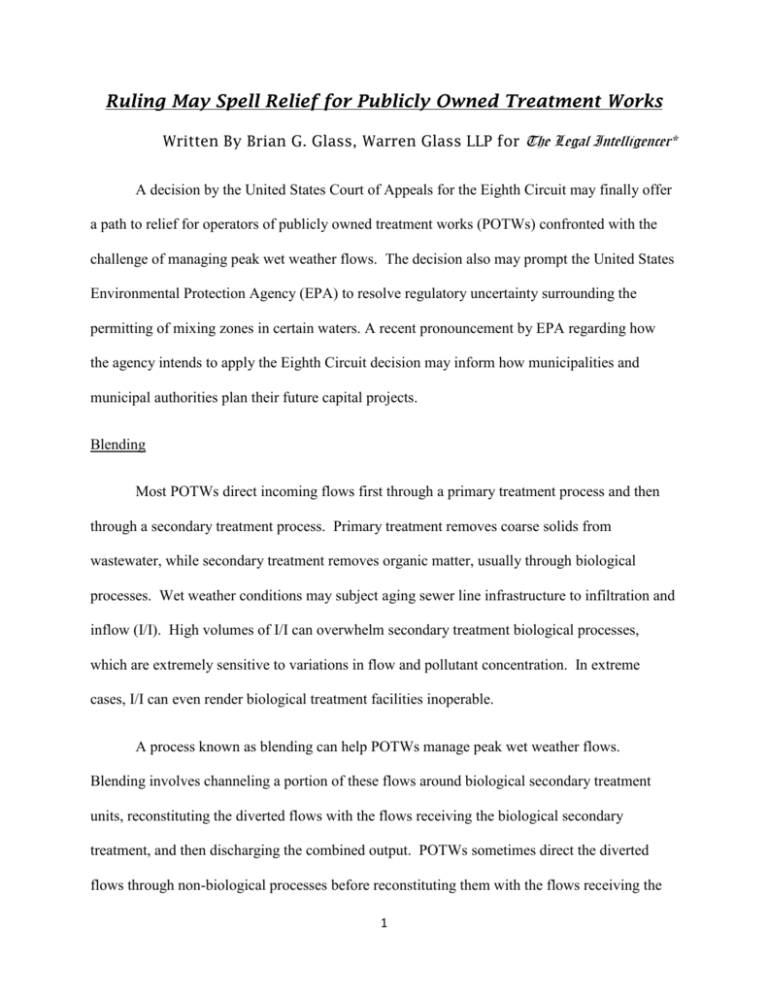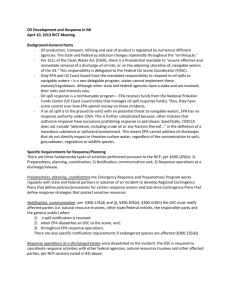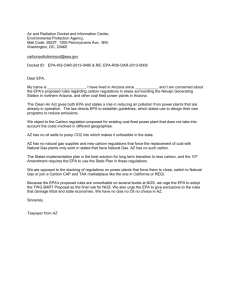
Ruling May Spell Relief for Publicly Owned Treatment Works
Written By Brian G. Glass, Warren Glass LLP for The Legal Intelligencer*
A decision by the United States Court of Appeals for the Eighth Circuit may finally offer
a path to relief for operators of publicly owned treatment works (POTWs) confronted with the
challenge of managing peak wet weather flows. The decision also may prompt the United States
Environmental Protection Agency (EPA) to resolve regulatory uncertainty surrounding the
permitting of mixing zones in certain waters. A recent pronouncement by EPA regarding how
the agency intends to apply the Eighth Circuit decision may inform how municipalities and
municipal authorities plan their future capital projects.
Blending
Most POTWs direct incoming flows first through a primary treatment process and then
through a secondary treatment process. Primary treatment removes coarse solids from
wastewater, while secondary treatment removes organic matter, usually through biological
processes. Wet weather conditions may subject aging sewer line infrastructure to infiltration and
inflow (I/I). High volumes of I/I can overwhelm secondary treatment biological processes,
which are extremely sensitive to variations in flow and pollutant concentration. In extreme
cases, I/I can even render biological treatment facilities inoperable.
A process known as blending can help POTWs manage peak wet weather flows.
Blending involves channeling a portion of these flows around biological secondary treatment
units, reconstituting the diverted flows with the flows receiving the biological secondary
treatment, and then discharging the combined output. POTWs sometimes direct the diverted
flows through non-biological processes before reconstituting them with the flows receiving the
1
biological treatment. One such process known as Actiflo uses ballasted flocculation to aggregate
and settle out suspended solids.
EPA has offered some interpretations of the Clean Water Act (CWA) that would appear
to allow blending and others that would appear largely to prohibit it. On the one hand, EPA has
interpreted the “technology-based” permitting scheme established by the CWA as requiring a
minimum level of treatment based on available treatment technologies without imposing any
particular technology to achieve that minimum level of treatment. EPA regulations also apply
effluent limitations at the point of discharge into navigable waters unless monitoring at the
discharge point would be “impractical or infeasible.” These two interpretations would seem to
allow blending as long as the combined output discharged to navigable waters achieves the
minimum level of treatment required. On the other hand, EPA regulations prohibit “bypass,”
defined as the “intentional diversion of waste streams from any portion of a treatment facility,”
unless there are “no feasible alternatives.” This CWA interpretation, intended to “ensure that
users properly operate and maintain their treatment facilities” by requiring the movement of
incoming flows through the facility as designed, would seem largely to restrict blending.
Unfortunately, efforts by EPA to provide guidance on whether and under what
circumstances blending is allowed have only created additional confusion. In 2003, EPA
proposed a policy under which blending would not constitute a prohibited bypass and could be
authorized in a National Pollutant Discharge Elimination System (NPDES) permit as long as
certain specified conditions were met. Two years later, EPA replaced the 2003 proposed policy
with a different proposal under which blending would be considered a bypass and allowed only
if there were “no feasible alternatives.” As with its 2003 predecessor, EPA never finalized or
adopted the 2005 proposed policy.
2
Bacteria Mixing Zones
When technology-based effluent limitations are inadequate to achieve water quality
standards, the CWA requires the imposition of water quality-based effluent limitations. EPA has
interpreted this requirement as allowing for “mixing zones,” which the agency has defined as
“[a] limited area or volume of water where initial dilution of a discharge takes place and where
numeric water quality criteria can be exceeded.” In effect, a mixing zone allows a discharge to
exceed applicable water quality criteria at the end of the pipe and in the immediate vicinity of the
outfall as long as it is sufficiently diluted as it moves downstream.
Although EPA regulations clearly allow states to issue NPDES permits that incorporate
mixing zones in at least some instances, EPA has sent mixed signals regarding whether bacteria
mixing zones are allowed in waters designated for “primary contact recreation.” Some EPA
materials have merely cautioned that mixing zones should be utilized in ways that “ensure . . .
there are no significant health risks, considering likely pathways of exposure” and “should not be
permitted where they may endanger critical areas,” such as “recreational areas.” Other EPA
materials have provided that all bacteria mixing zones in waters designated for “primary contact
recreation” carry potential health risks and “should not be permitted.”
The EPA Letters
In the face of this uncertainty, an association of municipalities in Iowa known as the Iowa
League of Cities (League) enlisted the assistance of Senator Charles Grassley to try to obtain
clarification from EPA. The EPA issued two letters in response to the League’s inquiries, one in
June 2011 and one in September 2011. In response to an inquiry about blending and whether
municipalities could use processes “such as Actiflo . . . to augment biological treatment and
3
recombine the treatment systems prior to discharge, without triggering application of federal
bypass [regulations],” the June 2011 letter merely summarized EPA’s 2005 proposed policy.
When the League sought additional clarification regarding whether the June 2011 letter meant
that municipalities could only use Actiflo if there were no feasible alternatives, the September
2011 letter responded in the affirmative, explaining that Actiflo fails to “provide treatment
necessary to meet the minimum requirements provided in the secondary treatment regulations.”
In response to an inquiry about mixing zones, the June 2011 letter, while acknowledging the
authority of states to include mixing zone policies in their water quality standards, flatly stated
that all bacteria mixing zones in waters designated for “primary contact recreation” “should not
be permitted.”
The Legal Challenge
The Administrative Procedure Act (APA) requires administrative agencies like EPA to
follow its notice and comment procedures when it undertakes rulemaking. A reviewing court
may set aside agency action, including a rulemaking, if, among other reasons, the agency fails to
observe these procedures or if the action is “in excess of statutory authority.” In Iowa League of
Cities v. EPA, 711 F.3d 844 (8th Cir. 2013), the League asked the Eighth Circuit to set aside the
action that EPA undertook in connection with its June and September 2011 letters for both of
these reasons. In its procedural challenge, the League argued that the two letters effectively
announced new legislative rules for blending and bacteria mixing zones in waters designated for
“primary contact recreation” that EPA implemented without observing the formal notice and
comment procedures required for agency rulemaking. In its substantive challenge, the League
argued that both of these rules exceeded EPA’s authority under the CWA.
4
In connection with the League’s procedural challenge, the Eighth Circuit found that the
June and September 2011 letters created a “new legal norm” amounting to legislative rules on
blending and bacteria mixing zones. On bacteria mixing zones, the court found that the letters
effectively “created a new effluent limitation: state permitting authorities no longer have
discretion to craft policies regarding bacteria mixing zones in primary contact recreation areas.
Instead, such mixing zones are governed by an effluent limitation that categorically forbids
them.” On blending, the court found that the letters essentially “mandat[e] certain technologies
as part of the secondary treatment phase” instead of allowing dischargers to select any
technology capable of meeting secondary treatment regulations and effectively “appl[y] effluent
limitations within facilities’ secondary treatment processes” rather than at the end of the pipe.
The court held that EPA violated the APA by promulgating both rules without first proceeding
through the APA’s notice and comment procedures and vacated both rules on that basis.
On the League’s substantive challenge, the result was decidedly more qualified.
Regarding bacteria mixing zones in waters designated for “primary contact recreation,” the court
found that the rule set forth in the June and September 2011 letters was “not obviously precluded
by the plain meaning of any applicable CWA provisions.” For that reason, the court declined to
vacate the rule on bacteria mixing zones as exceeding EPA’s statutory authority and provided
that “should the EPA wish to institute this rule, it may seek to do so using the appropriate
procedures.” Regarding blending, the court found that the CWA only authorizes EPA to regulate
discharges of pollutants from point sources into navigable waters and therefore concluded that
EPA lacked authority under the CWA to regulate the discharge of flows from one internal
treatment unit to another. The court held that the rule on blending “clearly exceeds the EPA’s
statutory authority” and vacated the rule on that basis.
5
EPA filed a petition for a rehearing en banc, which the Eighth Circuit denied. EPA did
not file a petition for writ of certiorari with the United States Supreme Court.
Conclusion
Iowa League of Cities v. EPA undoubtedly represents a major victory for POTWs,
particularly those struggling to manage wet weather flows. Due to the structure of our federal
court system, however, a decision by a circuit court is only binding within the circuit, and
agencies that believe a case was wrongly decided by a circuit court may elect not to abide by its
decision outside of the circuit. Unfortunately, that is precisely the election EPA appears to be
making in this instance. At a law seminar hosted by the National Association of Clean Water
Agencies (NACWA), Nancy Stoner, Acting Assistant Administrator for Water at EPA,
announced that the agency only intends to treat the decision in Iowa League of Cities v. EPA as
binding within the Eighth Circuit. Outside of the Eighth Circuit, EPA intends to decide whether
or not to apply the decision on a case-by-case basis.
Operators of POTWs outside of the Eighth Circuit who seek to establish a mixing zone in
a water designated for “primary contact recreation” and/or implement a blending process at their
facilities and who are completely ready to wage a legal battle with EPA over these issues will be
well-armed with the persuasive authority that the Eighth Circuit rendered in Iowa League of
Cities v. EPA. All other POTW operators outside of the Eighth Circuit would do well to
carefully monitor how EPA applies its case-by-case approach before committing time and
resources to a permit application that contemplates a mixing zone in a water with a “primary
contact recreation” designation or that proposes to retrofit a POTW with Actiflo. Unless fully
6
prepared to lock horns with EPA over these issues, anything more risks pouring taxpayer money
down the drain.
Brian G. Glass is a partner at Warren Glass LLP, an environmental and water resources law
practice located in Bryn Mawr, Pennsylvania. He may be reached at
bglass@warrenglasslaw.com.
Reprinted with permission from the December 13, 2013 edition of The Legal
Intelligencer©2013 ALM Media Properties, LLC. All rights reserved.
Further duplication without permission is prohibited.
For information, contact 877-257-3382, reprints@alm.com or visit www.almreprints.com.
7










